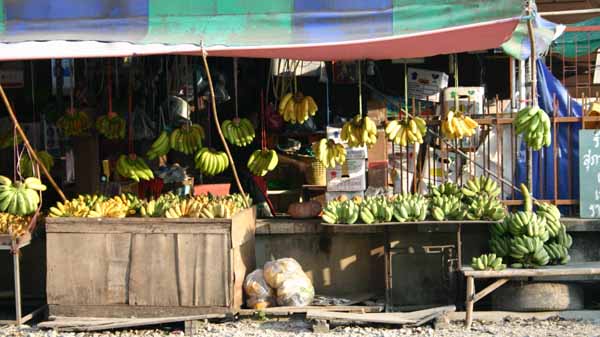
A road-side banana stall in Chiang Mai.
It would be hard to imagine Thailand without the banana. The fruit actually is believed to have its origins in southern Thailand, along the Malay peninsula. Even today, there are many different types of bananas available in Thai markets, varieties you will have never seen in western supermarkets. In all, the country is home to more than 30 varieties of banana, with common names such as "egg" (gluay kai), "100 bunches" (roy wee), "fragrant gold" (hawm tong) and "sandalwood" (jun).
Bananas are grown throughout the country, with some regions becoming famous for various types. The northern Thai province of Kampangphet, south of Chiang Mai, specializes in the egg banana variety, and an annual fair is held to celebrate it. Banana trees will grow easily in just about any type of soil, which makes them popular in tropical gardens as well as commercial farms. According to some resources, the banana is technically not a tree, but an overgrown herb. My own view is that any plant that grows taller than me is a tree.
Bananas are probably one of the world's oldest cultivated fruits. Westerners first encountered them when Alexander the Great attempted to conquer India in 327 B.C. In 1516 Friar Tomas de Berlanga set sail for the Caribbean with some banana roots which quickly took hold in the fertile soil.
Thais use almost every part of the banana tree in addition to the fruits. The leaves can be used as a serving plate, food wrapping, roofing material, ceremonial lanterns and even as a floor polisher. You can find banana leaves on sale in the fresh markets around Chiang Mai, folded up like freshly laundered bed sheets. The soft pith at the center of the trunk is often used to feed pigs, while the outer layers can be used to make string. Banana flowers often appear in salads as well as some stir-fries. But of course it is the plentiful fruit that everyone loves the world over.
Given its many uses, it will come as no surprise that the banana plays an important role in Thai culture as well. You will see bananas as offerings on the alters at homes and businesses, and even at weddings. Because the banana tree grows in any kind of soil, and then bears several suckers that multiply, it signifies abundant food, a long and prosperous life, and a big, united family.
Large, fairly sweet bananas similar to the type found in western supermarkets are called gluay hawm, or "fragrant banana" in Thai. These are typically used to make banana bread and other sweet cakes, as well as eaten raw. More common are smaller firm fruited varieties, the most abundant of which is called gluay nam wah, which doesn't appear to have any meaning in English. These bananas are generally less sweet and the flesh can be quite firm. The various ways that these "baby bananas" can be prepared seems almost endless. Grilled "barbecued bananas" are quite a common sight on the streets of Thailand. The fruits are simply peeled and roasted over hot coals.

Bananas cooked in sweet syrup to be served as a dessert.
Bananas also appear in many sweet desserts, usually accompanied by coconut milk. One common sight you may find a bit odd are red bananas. These are not a special variety that is naturally red. Rather, the bananas are soaked in red coloreds hydrolyzed lime water, made with lime powder obtained from fossilized shells dissolved in water. The soaking hardens the bananas so that they don't fall apart when later boiled in syrup. Red bananas may be eaten on their own, or served in sweetened coconut milk.
The fruits are not the only part of the banana tree that is edible. The large buds of the banana flower are also eaten in Thailand. The dusky purple blossoms are a bit longer than the average hand and about four inches in diameter. It seems odd to call something so large a "blossom", let alone a "flower."
The flower appears at the end of a long stem that grows out of the top of the banana tree. As it begins to blossom and bear fruit, the nearly two meter long stem bends to point downwards from its own weight. The flower is surrounded by several rows of male flowers, while further up the stem are the female flowers that will develop into fruits. Since each tree will have only one blossom, while producing up to a hundred bunches of bananas, blossoms are somewhat more rare in the market. A stall appearing to have hundreds of kilograms of bananas may have only half a dozen blossoms for sale.
The inner leaves of the banana blossom are creamy white in color and are the part eaten. I like to compare banana flowers to artichokes. They have a similar taste, and like artichokes, you end up discarding a lot of the banana bud before you get to the edible part. The raw buds can be rather bitter. Most recipes call for the sliced or shredded hearts to be soaked in lime juice for about 10 minutes before use. The blossoms can be eaten raw, although sometimes they are steamed or even roasted. The leaves of the flower are commonly eaten raw with chili dips around Chiang Mai.